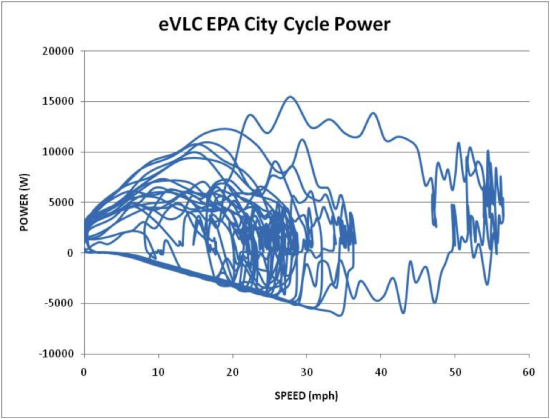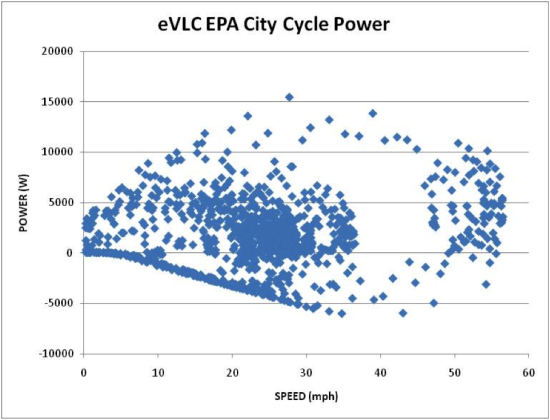Squiggly Lines, Dots and the Art of Data Analysis
One of the cool things we get with official EPA test results for our electric car is instantaneous voltage and current draw readings. Since the eVLC runs on DC electricity, it’s simple to calculate power: it’s voltage multiplied by current.
Suppose at some point on the test the car draws 53 Amps at 107 Volts, the power is 53 x 107 = 5671 Watts or 5.671 kW. There’s a direct conversion from this to horsepower: 1 hp = 0.746 kW so in our example we’re using 5.671/0.746 = 7.6 horsepower.
The voltage and current readings taken by the lab allow us to plot the power consumption in different ways and study and learn from the results. Consider the graph below which plots power against speed for the FTP75 EPA City test

Speed in miles per hour is on the X-axis and Power in Watts is on the Y-axis. Inspection tells us lots of things. For example, the maximum speed of the test is about 56 mph, second, the maximum power required is just over 15 kW (about 20 horsepower), the majority of the test is run below 40 mph and, because the power is sometimes negative, we are using regenerative braking (regen).
On closer inspection it gets more interesting. The City cycle involves 23 stops and starts and each launch is reflected by its own loop in the power/speed trace. There is only one excursion above about 36 mph and the power required to accelerate the car is much greater than that required to maintain it in the cruise portion at about 50 to 55 mph.
Where it gets really interesting for an engineer is the convergence to a sloping line beneath zero power, meaning it’s to do with our regenerative braking. That this is a straight line indicates there is a torque limit to our regen: our relatively simple controller has a limit on how much it can cull from the motor and put back in the battery while the car is slowing.
Could we improve the regen and thereby make our numbers even better? That’s where the art comes in. Consider the graph below which is of exactly the same data as the first chart but with the measurements presented as points rather than a line.

Inspection shows us something interesting that’s not obvious in the smoothed line format – there are many more data points above zero power than below. Since the data points are taken at even time intervals, it becomes clear that even on the City cycle where you’re stopping and starting all the time, it’s how much energy you spend that dominates, not how much you recover through regenerative braking.
This has a number of profound implications for the design of the car, which have been a theme through everything Edison2 does - and you’ll see this if you read back through the various papers we’ve presented on this blog.
First, let’s consider whether we could do better if we had a better motor/regen controller, one that allowed us to recover the energy that might be available below and to the left of the present torque limit. The answer is, we could, but at what price? Right now we’re using inexpensive, off-the-shelf components and we’ve put up the best official EPA test numbers ever, by far. One of the core points we make at Edison2 is that we have superb performance with here-and-now technology. If we had a gold-plated, mil-spec controller we could do a bit better still but you’d have to be rich to afford it.
Second, the relative lack of points below zero power indicate that you can’t make great numbers, even with best in the world regen, if you’re spending energy like crazy to move a heavy square box along the road. The secret is to not spend it in the first place and that’s what the Very Light Car is all about
Third, regen has consequences. Most electric cars are front wheel drive because, since that’s where the weight goes when the car brakes, that’s where you can recover the most power. Front wheel drive has the disadvantage that the driving wheels must also steer so you have to move the power through articulating couplings in the driveshafts. This causes mechanical drag and it puts extra parts in the airflow, causing aerodynamic drag. At Edsion2 we realized the car spends much more time being driven than slowing so we deliberately chose rear wheel drive because we could package everything better for aerodynamics and it’s mechanically more efficient.
So, once again, testing by an impartial lab to a recognized standard has produced results that demonstrate the fundamental correctness of our methods and approach. We know we are on the right path and the results confirm it.


 Wednesday, October 19, 2011 at 01:10PM
Wednesday, October 19, 2011 at 01:10PM
Reader Comments (12)
Like I have been telling all of my friends, this car is brilliant! I can't wait to buy one of these cars! Any idea of how long it will take to get these vehicles ready for mass production? I would absolutely go for an electric or hybrid VLC. (Could call it the hVLC - h for hybrid).
We are trying. The key to the car is being careful with every part. This creates the problem that no part exists readily from anyone to just buy.... this is the obstacle but it is also the great industrial opportunity. I am on my way to China again to both speak and to make connections with people who eventually make the light bits... In the end i would like to see some of this opportunity being executed in the USA but it seems that China is more receptive so we will not forever swim upstream. It is happening but it will take time. We do have some real large orders so we are figuring it out. but here you have to be careful what you wish for. So for example for us to make the car at the good price which is essential (less than 20k) the parts must be made in an industrial scale. For example the front suspension and sub assembly which will include wheels to brakes to shocks to x member to steering and pedals will cost less than $1000.-- it is simpler and better than most and it weighs less than 100 lbs i would guess (the tires are the heaviest thing). but we have to make 10000 for the price to happen... 10000 x $1000.-- is 10 million.... it adds up... really fast. Anyway we are on it. I can not give you a date but i know we will sell every one of them... we have the orders. Once the system is in place they will keep coming... i would say still years but not forever. It is all about finding money now...
Hi Oliver
I too look forward to driving a VLC one day and I hope that that day will be sooner than in a few years time. Having worked in an engineering start-up company myself, I understand the pressures that Edison2 must be facing and the timelines necessary to bring a vehicle to production. Despite this, I'm sitting here pining for a VLC! Is there any way that Edison2 could sell plans or basic kits so that impatient customers like myself can get in on the action? It may be end up being cheaper for me to build the car as I wouldn't have to pay the high vehicle sales tax imposed by my country (South Africa).
These are pretty good figures. I think you should explain it in a simpler manner so that many of us will understand it better.
Please Join me in letting the UAW know that we are committed to not buying a new car until the VLC is on the market. I would suggest that they should go on strike in 18 months if this thoughtfully engineered vehicle is not headed for production.
Attn: Bob King
UAW Solidarity House | 8000 East Jefferson Avenue
Detroit, Michigan 48214 | p. (313) 926-5000
Please join me in suggesting to the mayor of Detroit that one way to put his town back to work is to push for the production of a car that people want. I would even suggest the outlandish idea of a worker owned cooperative.
Mayor Dave Bing
City of Detroit
Coleman A. Young Municipal Center - Suite 1126
Detroit, MI 48226
Please join me in thanking Ford for not taking a bailout, and suggesting that they follow up with a wise decision...build this car.
Ford Motor Company
Customer Relationship Center
P.O. Box 6248
Dearborn, MI 48126
"...In the end i would like to see some of this opportunity being executed in the USA but it seems that China is more receptive..."
Can you expand on that? What are the obstacles? Are there public policy changes you would like to see? How much more would it cost to build it here?
I co-own the two largest solar generating facilities in Virginia (miniscule relative to what has been installed in other states) and Dominion Virginia Power is actively pursuing 2 courses of action at this very moment to stifle renewable energy production in this state. If you can't figure out why big auto & oil corps don't want this vehicle to see the light of day, you need to grow up.
Mark Scott,
I want to apologize for responding to your post as I did. I am deeply frustrated that we are so lacking in wisdom as a culture, that another dollar in our pocket is more sought after than our neighbor's well being. I appreciate the fact that others out there want to see this car on the market.
Well I can tell you this Oliver; my mother's business failed because she kept trying to produce products in the United States, and she had the option of seeking alternative production in China. She didn't take the opportunity, and eventually it collapsed. So my advice is to keep all options open, and we're routing for you. As much as I want to buy a VLC now, I would rather wait for it to be right. I also want the VLC to be built for the right reasons, rather than purchasing limited prototypes that, no lower income person who needs to get a more efficient vehicle could ever possibly afford. Don't worry there will come a time when all countries and inhabitants are forced to wake up and change their glutenous oil guzzling ways.
The best of luck to you with finding money. I think your best bargaining chip is that you guys deliver what you say you can, and have already triumphed in getting better mileage out of a 4 seater car than a 3.5 hp moped! hmm, Maybe a flying carpet should be your next project. Take care guys.
The other interesting thing you can see from this is that a serial hybrid with about a 5KW generator and a suitable buffer (battery, or ultracapacitor) could run as long as it had fuel. Hard to say if the efficiency/cost/complexity of that would be a win over a straight engine-powered car with a more detailed sketch at the engineering.
I'm lovin' the new video guys! Man, to see all this from start to finish, what a journey you guys have been through. It's just really inspiring to see that kind of dedication, and I can tell just from watching the car how much both the car and you guys have evolved from the "go-kart" looking VLC in the first movie. Incredible gentlemen!
I like your prject very much. I think it is a waste that no super efficient cars are for sale at the moment.
I also liked the idea of the Aptera. So what is your strategy to avoid getting bankrupt as Aptera did recently?